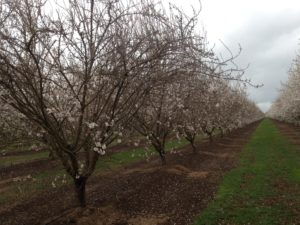
As forecasted, the weather for bloom 2017 looks wet. This will impact the number of fungicide applications, how we apply the material, orchard access, and bee concerns. This article is a follow up to what was written last week.
Periods of leaf wetness favor fungal pathogen development. Although there are no specific models for blossom pathogens, I general suggest applying a fungicide prior to a rain event in which leaf wetness exceeds 24 hours. This suggests that short, passing storms may not need a fungicide spray, but multi-day storms or multiple passing showers would. With the impending week of wet weather, fungicide applications to reduce the occurrence of disease is strongly encouraged. More on fungicide selection can be found here at the UC IPM website.
Fungicides should be re-applied every 7-10 days during periods of heavy rains, and 10-14 days if rain is lighter. This coming storm is a good example of when to apply at closer intervals in which 7 days of rain are expected to drop 3″ within Merced County.
Orchard access may be difficult in fine textured soils. This may limit the ability to apply by ground rig. Although aerial application does not provide as effective coverage as a properly calibrated ground rig at bloom, it still is effective in preventing disease. Aerial applications should be considered if field access is limited. I developed a list of aerial applicators and it can be found here. Please note that this is not an endorsement for any company, and if a company was omitted, please let me know so I can update the list.
Applications should be completed with enough time to dry. Fungicides need about one hour to be rain-ready.
Many fungicides contain spreaders or stickers. If choosing to add an additional material, please check the UC IPM website for up-to-date bee safety information for adjuvants, fungicides, and insecticides. Also check the pesticide label to determine if the adjuvant may interfere with the active ingredient.
With multiple fungicide applications occurring within fields, this might be a good year to consider the use of Bt to assist with peach twig borer control. More on that here.

